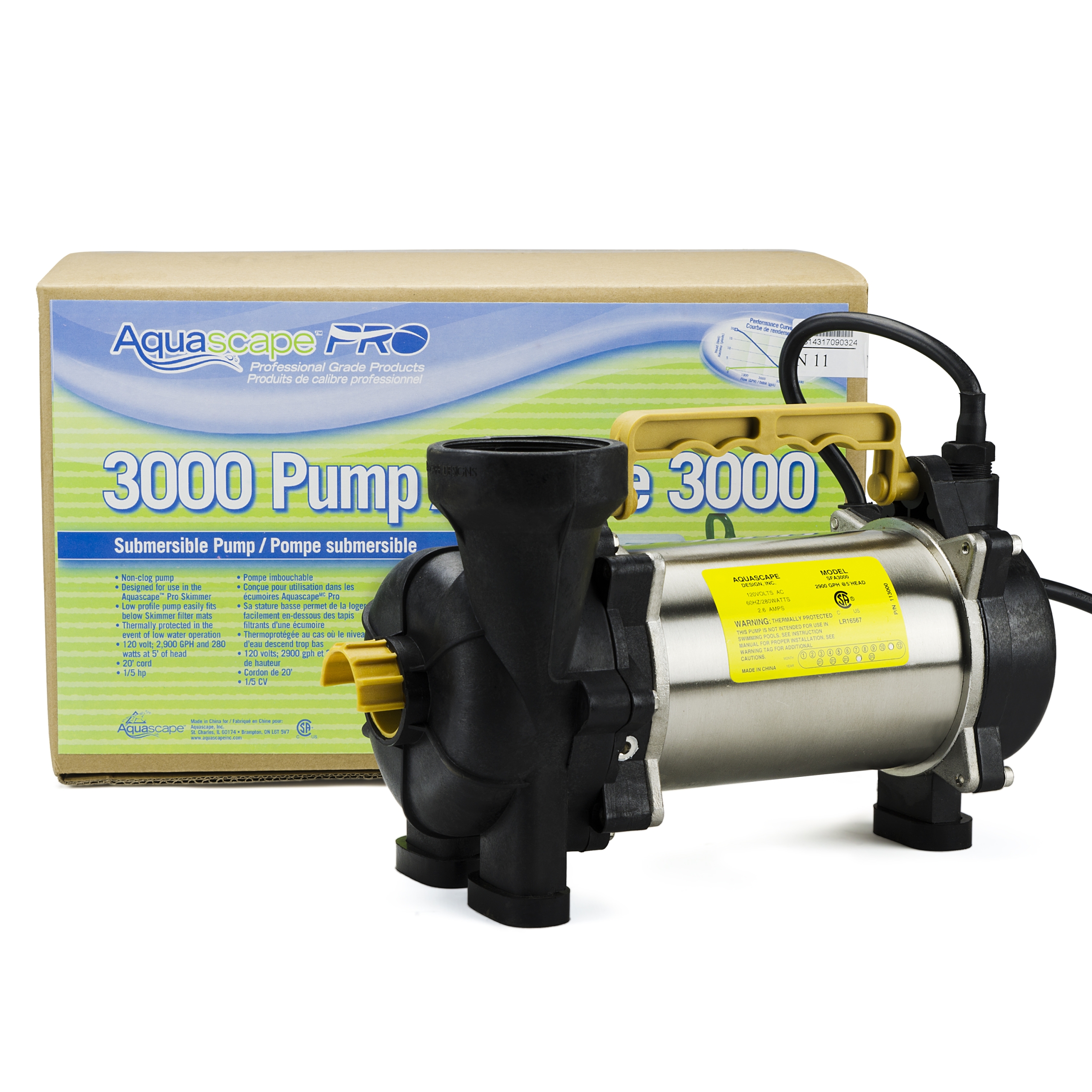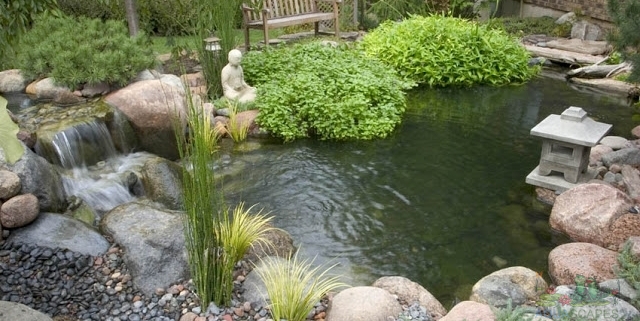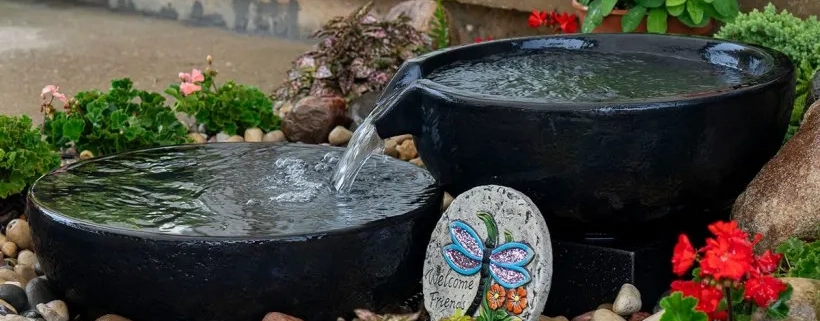Best Pond Pump Information 2021
Pumps keep the water in your pond healthy. They help evenly spread nutrients in the water to fish, plants and other aquatic life. Running water prevents stagnation and cuts down on algae and mosquitoes. Keeping the water moving ensures that oxygen levels are distributed throughout the pond. Pumps also provide power for a pond’s water features, like waterfalls and fountains.
This guide will help you learn about the best pond pumps for your garden.
~
The best water pumps for your pond and its fountain or waterfall come in variety of types and styles. They include submersible, external, magnetic drive and direct drive. Each of these water garden pumps offers its own advantages.
Submersible Pumps: These pumps are designed to work while wholly submerged in water. Typically, they are installed in the deepest part of the pond. Submersible pumps can be placed either directly into your pond or in a skimmer box or pond vault.
- Easy to install.
- Work well in environments that capitalize on a natural setting.
- No need to camouflage the pump.
- Run very quietly so there’s no distracting noise in your garden.
- Submersible pumps can be used to drain your pond, if needed.
- Range in pumping size from 50 to 5,000 gallons per hour.
- Can generate higher energy costs than other pump types.
- For smaller ponds, submersible pumps are generally more economical.
Tip: Some submersible pumps use oil to operate. If the pump seal breaks and leaks harmful oil coolant into the water, fish can be hurt or killed. If you have fish or other aquatic life in your pond, you’ll want to look for a submersible model that does not use oil.
External Pumps: External pumps can move a high volume of water, yet usually have lower energy costs than submersible pumps. They are not as quiet as submersible pumps. They should be placed in a dry location near your pond. External pumps are a lot more complicated to install. However, they are generally more reliable.
- Available as self-priming pumps able to draw their own water.
- Can be loud, disturbing the quiet of your garden.
- Work well for larger ponds that are 1,000 gallons or more.
- Offer long-lasting performance and easy repair.
- Require less routine maintenance than submersible pumps.
Tip: Pumps that are not self-priming can burn out a motor if the power shuts off momentarily and then comes back on. Protect against this by installing a check valve.
Magnetic Drive: In a magnetic-drive pump, an electrical charge creates a magnetic field that causes the magnet on the impeller to rotate and pump water. Since they have no seals to wear out, they require little maintenance. Occasionally, you will need to clean the impeller and its chamber for the most efficient operation.
- Completely sealed. Magnetic-drive pumps do not require lubrication.
- Because they don’t contain oil, magnetic-drive pumps are safer for ponds with fish, since oil leaks don’t occur.
- Don’t generate high head heights. Magnetic-drive pumps are unable to lift pond water vertically, which you might need to supply water to a fountain. They are not the best water pumps for fountains.
- Work best in cleaner environments with little or no debris.
- Highly efficient and cost-effective.
Direct Drive: Direct-drive pumps have an enclosed motor that is powered by electricity, which turns the impeller shaft.
- Achieve significant head height, so they are able to move water vertically. They are among the best water pumps for fountains and waterfalls.
- Typically more expensive to operate.
- Push water rather than pulling it.
- Not easily repaired.
Tip: Some models seal the motor in an oil-filled shell with seals around the cord and impeller shaft. These are risky to use if you have a pond stocked with fish. There is an ever-present danger of water contamination if a leak occurs. Many newer pumps, however, feature alternative lubrication that is safe for fish. Look for oil-free models if you have fish or other aquatic life in your pond.
Pond Pump Calculations
Pond Pump Features
Innovative Water Features: A New Era in Outdoor Design
Innovative water features are transforming outdoor spaces into dynamic, interactive retreats where technology, art, and nature meet. These cutting-edge designs go beyond traditional ponds and fountains to create immersive experiences that enhance both the aesthetic and functional appeal of any landscape. By integrating smart technology, sustainable practices, and artistic vision, innovative water features are setting a new standard for outdoor design. 💧
Merging Technology with Nature
At the forefront of innovative water features is the fusion of modern technology with natural elements. Advanced pump systems, like the Aquascape Ultra series, ensure efficient water circulation while minimizing energy consumption. These pumps work seamlessly with automated control systems that adjust water flow and lighting based on environmental conditions, allowing your water feature to operate at peak performance around the clock. This smart integration not only enhances functionality but also provides a captivating visual display that evolves with the time of day.
Interactive and Dynamic Installations
Gone are the days when water features were static displays. Today’s installations are designed to be interactive, inviting viewers to engage with their environment. Features such as motion-activated water jets, programmable LED lighting, and even sound-reactive elements can transform a simple fountain into an immersive experience. Imagine a water installation that adjusts its flow and color in response to ambient sounds or changes in weather—a true celebration of both art and innovation.
Sustainable Design for the Future
Sustainability is a core principle in the design of modern water features. Innovative designs often include recirculating systems that drastically reduce water waste and support a healthier ecosystem. By using native aquatic plants and natural filtration systems, these features create a balanced environment that requires less maintenance and is kind to the planet. Additionally, energy-efficient components such as LED lighting and eco-friendly pumps further reduce the environmental impact, making these installations both beautiful and responsible.
Customization and Personalization
One of the most exciting aspects of innovative water features is their adaptability. Homeowners and designers alike have the opportunity to customize every element—from the shape and size of the water display to the integration of multimedia elements like sound and light. Whether you’re designing a sleek, modern fountain for a corporate lobby or a whimsical, interactive installation for a residential garden, innovative water features offer endless possibilities for personalization. This level of customization ensures that each installation is a unique work of art that reflects the personality and vision of its creator.
The Benefits of Going Innovative
Embracing innovative water features goes beyond creating a visually stunning landscape. These installations can significantly enhance the value of a property, provide a tranquil retreat from the hustle and bustle of everyday life, and even serve as a conversation starter among guests. Moreover, the combination of technology and sustainable design practices positions these water features as forward-thinking investments that contribute to both aesthetic and environmental goals.
Final Thoughts
Innovative water features represent a bold step forward in outdoor design, blending technology, sustainability, and art to create experiences that captivate and inspire. By embracing these modern approaches, you can transform your outdoor space into a dynamic haven that evolves with your lifestyle and stands as a testament to forward-thinking design. Let your creativity flow and explore the endless possibilities that innovative water features have to offer. 😊
Innovative Water Garden Design
Water garden design is an inspiring blend of art, nature, and engineering—a creative process that transforms outdoor spaces into tranquil retreats. By carefully integrating water elements, plant life, and ambient lighting, you can create a captivating oasis that nurtures both the environment and your soul. Whether you’re a seasoned gardener or just beginning your design journey, innovative water garden design offers endless opportunities to explore and express your unique vision. 💧
Conceptualizing Your Vision
The first step in water garden design is to define a clear vision. Ask yourself: What mood do I want to evoke? Do I prefer a serene, reflective pond, or a dynamic cascade of waterfalls? Establishing your aesthetic goals will guide your choices—from the layout and scale of your water feature to the selection of plants and materials. A well-conceived plan not only boosts visual appeal but also ensures that every component works harmoniously.
Essential Elements of a Water Garden
1. The Water Feature:
The centerpiece of any water garden is the feature itself. It might be a still pond, a gently flowing stream, or an eye-catching waterfall. Energy-efficient pumps, such as the Aquascape Ultra series, ensure consistent water flow and proper oxygenation, which are critical for maintaining a healthy ecosystem.
2. Aquatic and Terrestrial Planting:
Plants are the living art in your water garden. Aquatic plants, including water lilies and lotus, add color and texture while also regulating algae growth through natural shading. Bordering these water features with marginal plants, like pickerel rush and water iris, creates a seamless transition between water and land, enriching the overall design.
3. Lighting and Ambiance:
Incorporating LED lighting into your water garden can elevate its charm, especially during evening hours. Soft, strategic lighting accentuates the gentle flow of water and casts inviting shadows across the landscape. It not only enhances safety but also transforms your garden into a magical nocturnal haven.
4. Hardscaping and Accessories:
Natural stone, gravel, and carefully placed sculptures provide structure and definition to your water garden. These elements anchor the design and add contrast to the soft, organic lines of the water and plant life. When choosing materials, consider both aesthetics and durability to ensure longevity in all weather conditions.
Embracing Sustainability
Sustainable water garden design is about harmonizing beauty with responsibility. Modern designs prioritize recirculating systems that reduce water waste and lower energy consumption. Utilizing native plant species can also promote local biodiversity and reduce maintenance efforts. Sustainable practices not only enhance the ecological value of your garden but also contribute to long-term cost savings.
Bringing It All Together
Successful water garden design is a blend of innovation, practicality, and personal expression. Every element—from the graceful movement of water to the carefully curated plant selection—plays a crucial role in creating a balanced ecosystem. The key is to experiment and refine your design until each component resonates with your original vision. With thoughtful planning and attention to detail, your water garden can become a dynamic sanctuary that provides endless enjoyment and tranquility.
Explore the possibilities, and let your creativity flow. Whether you’re designing a small urban pond or a sprawling natural retreat, embracing innovative water garden design allows you to create a timeless, eco-friendly masterpiece that enriches both your outdoor space and your life. 😊
A World of Water Lilies
Water lilies have enchanted gardeners and nature enthusiasts for centuries with their elegant blooms and tranquil presence. These aquatic treasures offer a stunning array of colors, sizes, and forms that can transform any water garden into a captivating oasis. Today, let’s explore the different varieties of water lilies, their unique characteristics, and tips on how to select the right types for your garden. 💧
Classic Varieties: Timeless Elegance
Nymphaea is the genus most commonly associated with water lilies, and its classic species have graced ponds and water gardens worldwide. Known for their broad, flat leaves and vibrant blooms, these varieties are perfect for creating a focal point in any outdoor setting. Their blossoms, ranging from pristine whites to brilliant pinks and reds, open wide during the day and close at night—a natural rhythm that adds to their charm.
Among these, the Nymphaea alba (white water lily) stands out for its simplicity and grace. Its delicate fragrance and pure white petals evoke a sense of serenity and balance, making it a favorite in both formal and naturalistic garden designs.
Exotic Varieties: A Burst of Color and Form
For gardeners seeking a bit more drama, exotic water lilies offer an exciting alternative. Species like Nymphaea caerulea and Nymphaea lotus bring a tropical flair to your water garden with their larger, more vibrant blooms. The blue water lily—despite its name—is often found in shades of purple or deep blue, creating a striking contrast against the green backdrop of foliage. These varieties thrive in warmer climates and can add an element of exotic sophistication to your outdoor space.
Additionally, hybrid water lilies have been cultivated to combine the best traits of different species. These hybrids often exhibit enhanced color vibrancy, larger blooms, and improved hardiness, making them ideal for gardeners looking to experiment with unique designs while maintaining the reliability of traditional water lilies.
Practical Considerations for Choosing Water Lilies
When selecting water lilies for your garden, consider the following factors:
- Sunlight: Most water lilies require full sun to bloom abundantly. Ensure your pond or water garden receives at least six hours of sunlight daily.
- Water Depth: Different species have specific water depth requirements. While many thrive in shallow ponds, some of the larger varieties may need deeper water to accommodate their expansive root systems.
- Climate: Choose varieties suited to your local climate. Hardy water lilies can withstand cooler temperatures, while tropical species require warmer conditions.
- Maintenance: Consider the growth habits of your chosen water lilies. Some may spread aggressively and require regular thinning, while others remain more contained.
Integrating Water Lilies Into Your Garden Design
Incorporating water lilies into your water garden is both an art and a science. Their natural beauty makes them ideal for creating serene focal points or accentuating the edges of larger installations. Pairing water lilies with aquatic plants like pickerel rush or water iris can create layered effects that mimic natural ecosystems. Moreover, adding underwater lighting can transform your water garden into a mesmerizing nocturnal display, highlighting the delicate hues and graceful forms of these aquatic beauties.
Water lilies not only enhance the aesthetic appeal of your water garden but also promote a healthy ecosystem by providing shade, reducing algae growth, and offering habitat for aquatic life.
Embrace the diverse world of water lilies to create a water garden that is as vibrant and dynamic as it is peaceful. Let each bloom tell a story of natural elegance and thoughtful design. 😊
Check out our store for all your water gardening needs! Aquascape products are Aquascape Inc. Certified.
Thanks for reading at Meyer Aquascapes! We hope you’ve enjoyed our post on garden pond design. Please leave a comment below if you liked it or have any questions. We’d love to hear from you! Thanks for stopping by!







